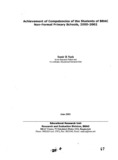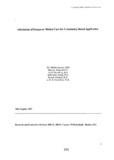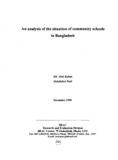Browsing BRAC Research and Evaluation Division (RED) Archive by Title
Now showing items 1-20 of 601
-
Accelerating the process of empowerment: the case of a poultry programme
(BRAC, 1995-06) -
Achievement of competencies of the students of BRAC non-formal primary schools
(Research and Evaluation Division, Brac, 2002-08) -
Achievement of competencies of the students of BRAC non-formal primary schools, 2000-2002
(BRAC Research and Evaluation Division (RED), 2003-06)Using the test instrument developed for Education Watch 2000, this study assessed the achievement of competencies of the students of BRAC non-formal primary schools. Three batches of students (second, third and fourth) ... -
Adaptation of Kangaroo Mother Care for community-based application
(BRAC Research and Evaluation Division (RED), 2002-08)Objective: Working with a multi-disciplinary team of Ecuadorians, Bangladeshis and Americans, we developed a simple protocol for community-based implementation of kangaroo mother care (CKMC) that does not require birth ... -
Adaptation of Kangaroo Mother Care for community-based application
(BRAC Research and Evaluation Division (RED), 2003-01)Objective: Working with a multi-disciplinary team of Ecuadorians, Bangladeshis and Americans, we developed a simple protocol for community-based implementation of kangaroo mother care (CKMC) that does not require birth ... -
Adolescent-to-adolescent development a pilot assessment of adolescent peer organised network
(BRAC Research and Evaluation Division (RED), 2003-08)This is an early assessment of BRAC's Adolescent Peer Organised Network (APON) programme - an initiative towards adolescent-to-adolescent development in order to acquire and share knowledge through peer organised network. ... -
Agarwood plantation at BRAC tea estate: introduction, environmental factors and financial analysis
(BRAC, 2008-06)The Aquillaria malaccensis (known as agar) produces agarwood which is used in perfumes, incense and medicines, and thus, can be extremely valuable. Excessive harvesting of agarwood has made this species threatened. ... -
Agricultural practice and its relation to poverty and food security in selected river basins in Bangladesh: a situation analysis
(BRAC, 2011-08)Poverty and food security in the context of Bangladesh has become a major concern over time. While efforts have been intensified to increase crop yield through increased land use, using inorganic fertilizers, pesticides, ... -
Alternative agriculture in Bangladesh: a study of UBINIG, CDA, and PROSHIKA Programmes
(BRAC Research and Evaluation Division (RED), 1997-12) -
Anaemia in pregnancy: a pilot study
(BRAC Research and Evaluation Division (RED), 1997-08)Anaemia in pregnancy is a common health problem. According to the last national nutrition survey of Bangladesh ( 1981-1982), about 47% of the pregnant and lactating women had anaemia. Since then, a few community-based ... -
An analysis of classroom culture of BRAC schools
(BRAC Research and Evaluation Division (RED), 1998-07)This study aimed at examining the classroom culture of two types of BRAC schools, i.e., Non Formal Primary Education (NFPE) and Chandina Learning Improvement Project (CLIP). Two schools from each category were selected ... -
An analysis of issues and problems of BRAC's Gonokendra Pathagar
(BRAC Research and Evaluation Division (RED), 1999-12)This study aimed at gaining a comprehensive understanding of issues and problems that effect the normal operation of BRAC Gonokendra Pathagar (community based library). Information was collected from six pathagars through ... -
Analysis of member performance: a case of BRAC's rural development programme
(BRAC, 1998-12)A comparative analysis of high performing and other BRAC members has been made to determine factors responsible for differences in their performance. It was found that both the success cases and other members owned similar ... -
An analysis of the situation of community schools in Bangladesh
(BRAC Research and Evaluation Division (RED), 1999-12)Contributing towards a strengthening of the government's Universal Primary Education Programme- Education For All- by the year 2000, has been one of the important aims of BRAC education programme. To materialize this aim ... -
An analytical assessment of GPL kit for field level detection of arsenic in water
(BRAC Research and Evaluation Division (RED), 1999-07)An attempt was taken to evaluate the suitability of GPL kit for field level detection of arsenic in water. The sources of variation in results of tests for arsenic determined by GPL kit seemed to be use of different sets ... -
Analytical documentation of the artificial insemination programme of BRAC
(BRAC, 2006-04)This paper intends to have feedback of the stakeholders of BRAC artificial insemination (AI) programme that could be useful for the programme. The findings show that implementers have to compete with other service provides ... -
Anemia and iron deficiency during pregnancy in rural Bangladesh
(BRAC Research and Evaluation Division (RED), 2000)Objective: To assess the prevalence of anemia, iron deficiency and iron deficiency anemia (IDA) among pregnant women in rural Bangladesh Design: Baseline data on 215 pregnant women who were invited to participate in ... -
Annual health check up for the members of BRAC's village organisation: an observation
(BRAC Research and Evaluation Division (RED), 2000-01) -
An appraisal of the BRACs NFPE Programme in respect to coverage of terminal competencies specified by the government of Bangladesh
(BRAC Research and Evaluation Division (RED), 1999-04)The study aimed to make an appraisal of the three-year Non-Formal Primary Education (NFPE) programme of BRAC in respect to the terminal competencies identified by the government of Bangladesh for the Formal Primary ... -
An approach to reaching the poor and disadvantaged to promote health equity in rural Bangladesh
(BRAC Research and Evaluation Division (RED), 2002)Although the health care system has significantly expanded in the rural areas of Bangladesh duri!lg the . last two decades, the overall health status of the population has remai~ed very poor because of the uneven distribution ...




















